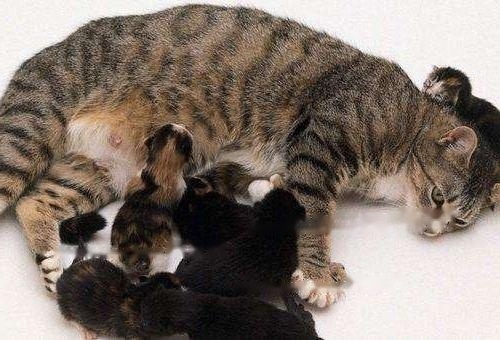There are a lot of things that cats need to pay attention to when giving birth. How much do you know about the nursing work from prenatal to postnatal? The following editor will tell you how cats give birth and the precautions for childbirth!
1. Prenatal preparation
1 week before the expected date of delivery, the owner should prepare the birthing box or Birth nest, and put it in a warm, dark, quiet place, so as not to be caught off guard by early labor.
The production box can be made of wood nails or replaced by cardboard boxes. The specifications are 50 cm long, 40 cm wide and 30 cm high. It can be straightened and left - a certain gap is appropriate. The door of the delivery box should leave a threshold of 7-8 cm high to prevent the kittens from running out.
The interior surface of the crate should be smooth and free of exposed nails or other sharp protrusions to avoid scratching the mother and kitten. The delivery box should not be painted with paint or other coatings to avoid bad odor to cats or poisoning caused by kittens licking.
The bottom of the production box should be covered with cotton wool, cloth and other thermal insulation materials, but should not use hay and other materials, because the kittens will run around in the box after birth to avoid getting into the sundries can not be found by the female cat and crushed to death, or other accidents. In winter, you need to spread more, and you can also use a hot water bottle or light bulb for insulation. In summer, pay attention to the ventilation and cooling of the production box.
The production box is best placed in a dark, dry place with warm winters and cool summers, and bricks can also be used to elevate the production box to facilitate ventilation. The top cover of the birthing box is preferably made into a loose-leaf type, which can be opened at any time, so as to observe the living conditions of the mother cat and the cubs.
Rinse and dry the mother cat's nipples with warm, brackish water prior to birth to ensure that the pups receive colostrum smoothly and hygienically. Before giving birth, the female cat should also prepare towels, scissors, disinfectant, warm water, etc. in case of dystocia.

2. Birth
A few days before the expected date of delivery, it is necessary to observe at any time, find out the signs of labor of the female cat in time, and prepare and care for childbirth. As labor approaches, pregnant cats become less active and frequently lick their abdomens and around their external genitalia.
The abdomen of the pregnant cat is significantly enlarged and sagging, the nipples are clearly visible, and sometimes milk flows. At this time, the pregnant cat is nervous, and it is easy to attack other animals and people. On the day of giving birth, female cats generally do not eat, hide in the delivery room and cannot come out, so the female cat in labor suddenly stops eating without the interference of disease, which is an important omen before labor. 12 to 24 hours before labor, the body temperature drops by about 1 ℃.
A few hours before giving birth, the female cat's uterus began to shrink. The female cat felt pain and felt uncomfortable, and was restless. She stayed in the delivery box and did not want to come out. Some female cats would lie down on their side. Shortness of breath. Between labor, cats may drink a lot of water. If you find mucus coming out of your vagina, it means you are about to give birth. If the cat is not in the birthing box at this time, you should put the cat into the birthing box as soon as possible, and gently stroke it until its mood is stable, and then let it stay alone in the birthing box. It is forbidden to watch it frequently, and it is not allowed to touch it.
Cat birth usually lasts 1 to 3 hours, depending on the litter size.
Under normal circumstances, the female cat can handle all matters during the delivery process by herself according to her maternal instinct, without the help of others. However, domestic cats, especially those of the rare breeds, sometimes need the assistance of their owners. Therefore, during the delivery process, the owner can watch on the sidelines and deal with the problem in time, but do not make noise. The less people move, the better, especially strangers. It is very important whether the first kitten can be delivered normally during delivery.
During labor, the female cat lies on her side. More mucus flows out of the vulva to increase the lubrication of the birth canal and speed up the delivery process. When the fetus is about to be born, the vulva is first seen bulging, followed by a white membrane that wraps the fetus. Usually the head is born first, the claws are placed on the sides of the head, and then the body and tail are born. The born kittens are wrapped in the placenta, and then the female cat tore the placenta sac, bites off the umbilical cord, and then eats the afterbirth and placenta, licks the amniotic fluid from the kitten's body, mucus in the nose, and sometimes sees It's normal for a mother cat to hit her cubs, which stimulates the kitten's circulatory and respiratory systems.
The first calf is born, and the interval is 0.5 to 1 hour, and the second fetus begins to be delivered. The mother cat will usually move away from the first kitten. The owner should also observe the whole process of the second fetus delivery, to prevent the mother cat from crushing or injuring the born kitten. Generally, after 3 to 4 kittens are produced, if the mother cat is not seen again after 1 hour, it means that the delivery is over. At this time, the female cat is very tired, so let her rest well without disturbing her, and sometimes you can give her a small amount of milk or warm sugar water.
Cats can also experience dystocia, which requires skilled labor.
If the birth is head first, this is a natural birth position. Some cats may suffer from dystocia due to weak body and insufficient productivity. At this time, the method of pulling can be used to assist the delivery. One person grabs the female cat's shoulder, and the other person uses gauze to pad the exposed fetal part and send it back to the pelvic cavity for about 1 cm; then gently turn the fetal body to rest, and then carefully pull it out while the mother cat is working hard. Under normal circumstances, the fetal light can be produced smoothly.
For breech dystocia, one person should hold the head of the female cat, the other person should gently press the abdomen and waist of the female cat with the left hand, and the right thumb and ring finger should lightly press the hind legs from the amniotic membrane for a few times, and then use The index finger and middle finger are attached to the back of the kitten, and the body of the fetus is bent to the abdomen into a shrimp shape, which can be smoothly delivered. If the two front paws come out first, use the index finger and middle finger to probe into the birth canal, hold the fetus's chest, and send the fetus to the uterus while the mother cat is working intermittently. Place and give birth.
The midwifery movement should be light and steady, patient and meticulous to prevent injury. Returning the fetus must be done when the mother cat stops working hard, and pulling outward must be slowly pulled along with the mother cat's efforts. If the fetus is still difficult to deliver by midwifery, a caesarean section should be considered.
Here are some things to keep in mind when your cat is giving birth:
First, be sure to keep it quiet and dark during labour , to prevent the cat from being too nervous and causing dystocia. During the observation, if it is found that the pregnant cat has broken water for 15 to 24 hours and still does not see the birth of the fetus, or sees that the fetus has exposed the vulva for 5 minutes and cannot be fully delivered, it means that the female cat is dystocia, and it is necessary to assist the delivery. If necessary, consider a caesarean section.
Second, during childbirth, the number of placentas must be counted. Usually, after the fetus is delivered, it is discharged immediately and eaten by the female cat. If the placenta does not fall, the consequences are serious. If it is not detected and handled in time, it may become infected, corrupt, and even endanger the life of the female cat.
Third, when the female cat gives birth, there will be a small amount of bleeding. If there is bright red excretion in the vagina after delivery, it indicates that the birth canal will bleed heavily. At this time, the vagina should be plugged with absorbent cotton. If you live there, send it to a pet hospital (or veterinary station) for treatment.
![[Dog Training 5] The training method of pet dog dining etiquette](/static/img/12192/12192_1.jpg)




